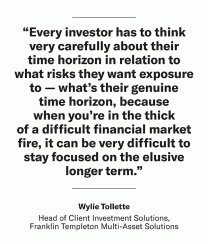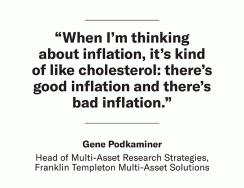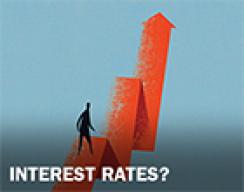The investment experts at Franklin Templeton spend a lot of time speaking to chief investment officers about “What if . . .” That is, the most beneficial discussions come from exploring the implications of what might happen—not guessing the future—and being prepared for those risks.
In the following conversation, two key players at Franklin Templeton Multi-Asset Solutions—Wylie Tollette, Head of Client Investment Solutions, and Gene Podkaminer, Head of Multi-Asset Research Strategies—consider the “what if” of inflation, including why it’s like a ninja (and a bit like cholesterol)
Wylie Tollette: Inflation is one of the more underappreciated risks out there. We’ve seen some recent CPI data for developed markets that have popped a little bit above expectation, raising a flag somewhere between green and yellow—to the point where we would recommend an in-depth understanding of how inflation risk translates across both assets and liabilities within the portfolio. Many liabilities—pensions, insurance, salaries, etc.—are tied to CPI.
Gene Podkaminer: This lime-colored flag we’re waving, it’s part of the portfolio and yet, oftentimes, it’s hidden. You’ll see exposure to inflation, in real estate certainly, in commodities absolutely, and in TIPS and linkers. You can quibble with the supply and demand issues of TIPS pricing, or if CPI is a great inflation measure, or whether it should be the GDP deflator or something else. But within TIPS, you do have actual exposure to inflation. Arguably, over longer periods of time, you will feel it in the equity markets also. To me, what’s interesting about inflation is that global growth is a well-known factor. Interest rates are well-known, well-appreciated. But inflation hasn’t gotten a lot of air time.
Tollette: A high inflation environment is unfamiliar to most people in developed countries. We haven’t seen high inflation in the US or most developed markets since the 1970s. Many portfolios have drifted away from explicit inflation hedging, which tends to be costly. People can tolerate the price, stand the opportunity cost for a few years, but then they get tired of paying to own commodities or specific inflation hedges or swaps, so they give up on that. That may be a rational choice, actually—to look for intrinsic inflation hedges that are built into other asset classes, such as in rental real estate, that don’t have the same opportunity costs.

Podkaminer: What we’re seeing now is more of a reflationary environment. When I’m thinking about inflation, it’s kind of like cholesterol: there’s good inflation and there’s bad inflation. I want to see good inflation that’s caused by productivity increasing in economies, by things overheating because we have healthy consumption. That, to me, is relatively good inflation. We understand how that cycle works and how to deal with it. Bad inflation is what you see happening in a lot of emerging markets where you’ve got very little control over monetary policy. As you relinquish that control, you start to see interesting things happening to your home inflation rate and also to your currency. That’s the bad cholesterol.

Tollette: Inflation is perhaps the factor most explicitly tied into many liability structures. If you’re a university endowment, salaries, expenses, and tuition have dramatically outpaced core inflation. If your endowment portfolio was tied to CPI, you probably undershot the mark in terms of how your liabilities around that have expanded. It’s important to understand what currency those obligations are denominated in, because even if the underlying cost driver isn’t changing that much, that currency may have an inflation component. This is important to think about as you’re structuring your portfolio to make sure your cash flows that come in are structured in the currency the payments need to go out in.
Podkaminer: Inflation is a ninja—you heard it here first. A shock to global growth will flatten you, but you’ll see it coming. Interest rates maybe are a little bit subtler; but again, you can see that coming. Inflation will kill you in stealth.
Tollette: It can creep up on you year after year. If you’ve counted on 3% inflation on your asset side and that’s what you targeted to achieve, but your obligations are increasing by 4%, that might not look like a lot in any given year. Over 10 years, however, that will create a real funding problem.
Podkaminer: We see intelligent investors couching their return expectations or their return objectives in real terms, which makes a lot of sense. Say you want to achieve 3.5% real. If inflation happens to be 4%, that’s okay. And if it’s at 2%, even better—at least the focus is on what you can control, which is the real portion of returns, and not being surprised when inflation isn’t what you expected.
Tollette: It always goes back to what’s the money for, and how that should influence your asset allocation and your benchmarking policy, and how you think about success and whether you’re increasing the probability of achieving your goals and your aims.Wylie and Gene are happy to speak to you about your “what if” scenarios. Feel free to contact them at solutions@franklintempleton.com:
Wylie Tollette, CFA, CPA
Head of Client Investment Solutions
Franklin Templeton Multi-Asset Solutions
Gene Podkaminer, CFA
Head of Multi-Asset Research Strategies
Franklin Templeton Multi-Asset Solutions
More in the series "What if there are shocks to ... "

Franklin Templeton
| 
Franklin Templeton
| 
FT demographics
| 
Franklin Templeton
|

Franklin Templeton
| 
FT-global growth
| 
interest rates
| 
FT
|
Disclaimers
This material is provided for informational purposes only and nothing herein constitutes investment, legal, accounting or tax advice. This material is general in nature and is not directed to any category of investors and should not be regarded as individualized, a recommendation, investment advice or a suggestion to engage in or refrain from any investment-related course of action. All information is current as of the date of this material and is subject to change without notice. Any views or opinions expressed may not reflect those of the firm or the firm as a whole. Franklin Templeton does not accept any responsibility to update any opinions or other information contained in this document. This material may include estimates, outlooks, projections and other “forward-looking statements.” Due to a variety of factors, actual events may differ significantly from those presented.
CFA® and Chartered Financial Analyst® are trademarks owned by CFA Institute.
For US Residents Only
© 2018 Franklin Templeton Investments. All rights reserved.






